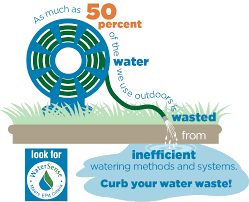Efficiency Tips
Californians use an average 146 gallons of water per day. Here are some easy ways to reduce water use.
In the Kitchen/Laundry Room
- Equip faucets with aerators. Installing aerators on kitchen and bathroom sinks can reduce indoor water use by about 4%.
- Operate your clothes washer and dishwasher with full loads only. By waiting until you have a full load of laundry or dishes, you’ll save on water and energy costs.
- Don’t leave the water running if you hand wash dishes. Fill the sink or a pail to wash and rinse dishes. Washing dishes by hand used 3-4x more water than a dish washer.
- Replace your clothes washer, the second highest water user indoors. New high-efficiency clothes washers can reduce water and energy use by 40%. Check out the District’s clothes washer rebate to save water and money.
In the Bathroom

- Fix toilet leaks. Toilet leaks are easy to identify and fix. Check that the water level in your toilet tank is not above the overflow tube; the water level should be about an inch below the top of the tube. Also, check your toilet flapper for proper seating and wear. Over time the flapper in your toilet tank becomes worn and does not work effectively to stop leaks into to the toilet bowl. To test for a toilet leak, place a few drops of food coloring or a toilet dye tablet in your tank. Wait a few minutes. If the coloring appears in the bowl, you likely have a leak.
- Install a high-efficiency toilet. Old toilets are the largest water users in your house. Check out the District’s high-efficiency toilet rebate to save 19 gallons per person/day
- Shower instead of using the bathtub and take shorter showers. A full bathtub can use 25-70 gallons of water, while taking a five-minute shower uses 10 to 25 gallons. If you take a bath, stopper the drain immediately and adjust the temperature as you fill the tub.
- Install low-flow showerheads. Replace older showerheads with new efficient models that use 2.5 gallons per minute or less. Older models can use up to 7 gallons of water per minute and can waste thousands of gallons per month.
- Turning off the tap while brushing your teeth or shaving. Remember that a typical faucet uses 2 gallons per minute!
Around the Yard

Did you know that outdoor water consumption typically accounts for 30-60% of residential water use? Here are some simple tips to reduce outdoor water usage while still maintaining a beautiful yard:
- Plant water-wise plants. Reduce outdoor watering needs by planting native and adapted species for Lake Tahoe’s climate. Plants native to the area are already adapted to the soil and weather conditions and will generally require less water and work to thrive.
- How to Install Drip Irrigation July, 2020 video
- Replace sprinklers with drip irrigation when possible. Use drip irrigation for trees, shrubs, and flowerbeds. Drip systems use less water and direct water where it is required by the plant. Check out the District’s Irrigation Efficiency Evaluation and Rebate Program.
- Water your lawn only when it needs it. Overwatering the lawn is a common wasteful practice. Step on your lawn; if the grass springs back up when you remove pressure, it doesn’t need watering.
- Set your irrigation schedule for the season and your local conditions. Watering times will vary by season, climate, soil type, and plant types. Remember to only water at night or the early morning on your designated watering days: Even numbered street addresses water Monday, Wednesday, and Friday. Odd-numbered street addresses water on Tuesday, Thursday, and Sunday. No landscape irrigation on Saturday, as that is our day of peak demand.
How much to water my Lawn. August 28, 2020
- Set mower blades to 3”. Encourage deeper roots and save 16-50 gallons per day.
- Reimagine your yard. If you only walk on your lawn to mow it, consider replacing with water-wise plants and trees that use little or no water once established. Check out the District’s Turf Buy Back Program for more information.
Tahoe Friendly Gardens. August 28, 2020
- Adjust sprinkler heads and fix leaks. Broken sprinkler heads waste water and can potentially damage your landscape. Check sprinkler heads, drip system emitters, and drip lines for breaks and cracks. Adjust sprinkler heads to not water surrounding pavement or forest.
- Sprinkler Spruce Up - July, 2020 video
- Sweep sidewalks and driveways. Hosing down pavement around your home can waste hundreds of gallons. A broom is the proper tool to clean these areas.
- Use mulch. Place several inches of mulch around trees and plants; a layer of mulch will slow the evaporation of moisture from your landscape and inhibit the growth of weeds.
- Install shut-off nozzles on all garden hoses. Make sure your garden hose has an automatic shut-off.

.png?ixlib=rb-1.1.0&or=0&w=720&h=720&fit=max&auto=format%2Ccompress&s=c717e7a107c52a5ffe965ea69f42545e)
